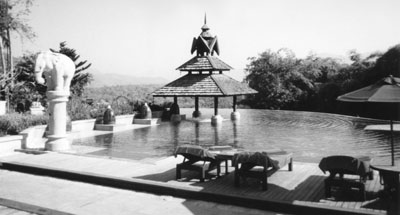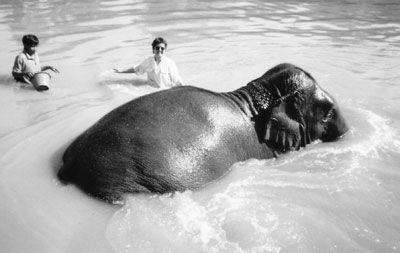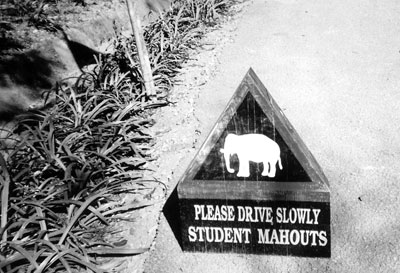Thailand — An elephant-driving school experience: what a mahout!
by Esther Perica, Arlington Heights, IL
If you think there are no thrills left in life, enroll in the elephant-driving school at Anantara Resort Golden Triangle’s elephant camp in northern Thailand. Not only is a stay the perfect antidote to transpacific jet lag (mahout training sessions begin at 6:30 a.m.), but visitors have an opportunity to spend extended quality time with one of the most spectacular animals in Asia.
Getting started
The animals based at Anantara officially belong to the government of Thailand, and, like many government employees, they have good unions — their workday runs from 6:30 a.m. to 3:30 p.m. When a conference at the hotel requested using the elephants as a dramatic backdrop for a special evening event, the hotel wouldn’t permit it as it would have interrupted the animals’ “routine.” I was very impressed with this decision.
Once my reservation for the “Mahout Training Package” was in place, John Roberts, director of the elephant camp, sent reading materials, including commands I needed to be familiar with before arriving, facts about elephants and a reading list. He was good about responding to e-mails and answering any questions I had.
After a one-hour flight from Bangkok to Chaing Rai, I was picked up by a hotel vehicle and transported another hour to the resort. That evening I attended a dinner briefing, where John advised about what to expect during the days ahead and offered appropriate clothing and footwear suggestions.
My first day began at 6:30 a.m. at the hotel’s front door. I didn’t need to worry about getting breakfast that early, as there was a coffee/tea setup in my room as well as a fruit basket that was changed daily. Also, by
6:00 there was enough set up on the restaurant’s lavish breakfast buffet that I could have a quick bite.
Out I went with John and my fellow mahouts to find the elephants, which had overnighted in the forest. After joining them in a slosh and a good scrub in the Mekong River, we returned to camp with the elephants and helped with their breakfast by hand-feeding them some of the 400 pounds of food, grass, trees, sugarcane and bananas they consume each day.
Know your elephant
I was assigned the elephant Lawann, which means “wild jasmine” in Thai, and we spent a few hours the first morning “bonding.” I fed her sugarcane and bananas and she inspected me thoroughly with her trunk. You might think the elephant is being affectionate, planting big wet kisses on your clothes or wrapping her trunk around your arm, but she is looking for treats.
Of course, I fell in love immediately. Those looks, those eyes and those big, wet, sloppy elephant kisses were very hard to resist.
Later that morning I learned to mount — without a ladder or platform for us mahouts, just a quick, inelegant scramble to the top with some assistance (a push from behind). I rode bareback astride her neck, as the driver’s feet must be in contact with the area just behind the elephant’s ears to deliver commands, a combination of verbal cues and foot movements.
Around 9 a.m. we “drove” our elephants back to the hotel’s entrance, then went in to breakfast. By this time, I was fairly ravenous and took advantage of tables laden with fresh juices, yogurt, cereals, homemade breads and jams, cheeses, chicken, beef and potato and rice dishes (which could almost serve as an early lunch) plus an omelet station.
The Anantara’s chef came from the Four Seasons Bangkok and it showed. The food was excellent, with imaginative, well-presented dishes at all meals. The breakfast was enough to carry me to dinner. You don’t want to miss the lunch salads, however.
Learning the ropes
The afternoon training session began at 1:30. It was time to practice simple commands in the slalom course: follow me (pae), go (pai), turn (baen), stop (how), etc. It wasn’t a question of teaching the elephant — she knew the commands. It was about being able to communicate and have a nice time working together.
Quitting time (for the elephants) was around 3, when we drove them back to the river area for another bath. Along the way, bins had been set out for them filled with tasty fruits, vegetables and leftovers from breakfast and lunch.
We selected a different trail each day, and Lawann took as much time as she wanted while she paused to eat shoots and leaves. I was always accompanied by the elephant’s own mahout, Kwan Nan, and either John Roberts or his assistant Amb or, often, all three.
What to pack
A bit of advice — mahouting is dirty work. The forest is muddy, and the animals like nothing more than blowing dirt all over themselves, then squirting water over that to keep their hides cool and moist.
Climbing aboard, even for an experienced mahout, is a messy experience. Bring at least two pairs of lightweight slacks (jeans are not recommended, as they take too long to dry); it is better to wear long pants rather than shorts, as the animal’s skin is rough. Add a bunch of old T-shirts and a swimsuit and water shoes for the river washings.
You will want to wash your clothes every night and probably throw them away after five days of mahout school. I did exactly that — all except for one T-shirt, stained with every morning’s kisses, that no matter how hard I scrub or soak is indelibly marked forever.
You may also want to keep a waterproof camera handy for your once-in-a-lifetime shots.
In between sessions, you are always welcome to return to camp and play with the elephants, but you can also enjoy the hotel itself.
The facilities
The elephant facility is an easy 15-minute walk (or elephant ride) from the main hotel. The camp is set up like a traditional hill tribe village with six full-time, in-residence mahouts and four elephants.
If you are familiar with Thailand’s hill tribe areas, you’ll quickly see this is a 5-star village. Large paintings done by the elephants adorn the outer walls of the thatched houses, there are tiled bathroom facilities for guests, and there is a comfortable seating area around the campfire.
Another big plus of the program is the opportunity to spend time with John Roberts. He has been involved in conservation programs in the U.K., Australia, Laos and the U.S. and is well respected in conservation circles for his tiger research at Tiger Tops Jungle Lodge in Nepal’s Royal Chitwan National Park.
Thirty-two-year-old John took on this new assignment three years before my visit. He designed and now operates the elephant camp with an emphasis on elephant conservation and care. During our time together, he introduced me to the lifestyle of Thai mahouts and helped me gain a greater understanding of the Asian elephant.
I also learned a bit about the King’s Cup Elephant Polo Tournament, which supports Thailand’s National Elephant Institute. It is hosted every September in Hua Hin, Anantara’s seaside resort, and John serves as official umpire. It is a true learning experience.
This elephant camp works closely with the Thai Elephant Conservation Center (TECC) in Lampang Province, Thailand, which acts as a central body for conservation of domestic and wild elephants and houses one of the few elephant hospitals in the world.
It is a sad fact that a century ago there were 100,000 elephants in Thailand, while today it is estimated that between 3,000 and 4,000 remain, and they are steadily decreasing by about 12% a year.
Mr. Tipprasert, one of the managing directors of TECC, and John Roberts were in negotiation to rescue those elephants located in southern Thailand that were left homeless by the tsunami, as the Anantara, at 160 acres, could comfortably support four more elephants at the time of my visit.
A royal country house
The Anantara sits on a hill overlooking the Mekong River. The feeling is of a royal country house where everything is open, making maximum use of the spectacular views. All 90 rooms and public areas overlook the expansive forest and grassland property in what is called the “Golden Triangle” of Thailand, Burma and Laos.
Special touches are everywhere. Beautiful artwork (with, of course, an elephant theme) hangs in all of the rooms and adorns public spaces, traditional musicians play on a temple-style platform in the pool and, at night, torches light the gardens and pool area. The property around the main building has landscaped gardens, reflecting pools and lagoons, while the rest is left natural for walking and elephant-riding trails.
Even the hotel’s library is excellent, not the usual mishmash of romance novels left behind by guests. Well-chosen books on Thai history and culture, flora, fauna, elephant lore and early exploration of the area fill two large bookcases.
I had a superior (standard) room, which was a good size and well designed and comfortable. All rooms have a balcony complete with a sofa and a table and chairs, providing a wonderful place to watch the sun melt down into the Mekong.
The stone bathtub could easily fit four people — or maybe one elephant (hmmm). You can recline in it and have a view through your room to the Mekong River and beyond. Spa-quality bath amenities are provided as well as four bottles of water daily.
Off campus activities
There is no problem filling your free time here. A good selection of imaginative tours and soft-adventure programs is available, and you can attend their cooking school, use the gym, go birding or take jungle walks on the numerous paths which double as elephant trails. There is also a full menu of spa treatments, including wraps, facials and poolside massages. The hotel’s spectacular infinity pool and Jacuzzi soon became one of my favorite spots, and I often had lunch poolside.
Sob Ruak village (1½ kilometers away) is a nice excursion destination, but walking there is not recommended as there is no sidewalk and cars zip around the curves. The hotel charges $8 for the ride, either by car or speedboat. A public taxi back costs just $2. The village has a temple and numerous shops, restaurants and Internet cafés.
The Hall of Opium Museum is just across the road from the entrance to the Anantara property. The exhibits were designed by the Smithsonian group and it is a worthwhile museum.
Something entirely different
Elephant-driving school was a good experience and one I’d recommend if your interests focus on animal conservation and elephants combined with a comfortable resort stay. You do bond with the animals, as their constant interaction with mahouts and hotel guests results in gentle, well-behaved, loveable and pampered pachyderms. And, as in all relationships, it was hard to say good-bye.
After six days at Anantara (I spent an extra day recovering from jet lag), I felt like I was leaving friends, both 2- and 4-footed. I left with tears in my eyes, clutching my certificate of completion. My mahout uniform, complete with my name embroidered in Thai lettering, was later delivered to my Bangkok hotel.
My 5-day/4-night “Mahout Training Package” ran $1,457, plus taxes, for a single superior room; there are also deluxe and suite accommodations.
Costs can range from $944 to $1,457, depending on the season, so it is a good idea to check the website for current rates, packages and specials. For more information, contact Anantara Resort Golden Triangle (Chiang Rai, Thailand; phone 011 60 5378 4084, www.anantara.com).
The Thai Elephant Conservation Center has also placed elephants at the nearby Four Seasons Tented Camp in the Golden Triangle (www.fourseasons.com/goldentriangle), and a similar training program is available there.
The elephant-driving school at Anantara is a great bargain, not only for the 5-star comfort but for a unique experience unmatched in any other country in the world.




